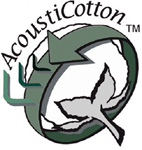| |
|
Breathe
Easier:
Is Fiberglass the 21st Century Asbestos?
Recent articles
have dubbed fiberglass the next asbestos, citing the pervasive dangers of
breathing in glass particles and potential carcinogens. Such claims and
accusations conjure up a myriad of emotions ranging from slight anxiety
to panic. Are these claims legitimate? Do you, as a designer, need to be
concerned?
What is it?
According to the American Lung Association, fiberglass
is a "man-made product that is composed of natural ingredients such as sand
and recycled products such as window glass and bottles. The ingredients
are melted and spun to create small strands of fiberglass that together
form 'glass wool'."
Exposure to airborne fiberglass particles or direct
contact with the product can cause skin, eye, nose and throat irritation
and itching. Coughing is also a reaction to inhaled fibers. To spite common
concerns regarding health and safety, fiberglass is widely-accepted a safe
product, when properly installed.
The following facts are figures are documented
in a June 14, 2002 report by the U.S. Department of Health and Human Services:
- Occupational exposure to some types of "vitreous fibers has been associated
with acute irritation of the skin, eyes, and upper respiratory tract."
- Possible "health hazards from long-term exposure to airborne fibrous glass,
rock wool, or slag wool includes effects associated with occupational exposure
to asbestos (lung scarring, lung cancer, and mesothelioma)…"
- The risks
associated with fiberglass are not as severe as those linked to asbestos.
- "The International Agency for Research on Cancer has most recently concluded
(in 2001) that insulation glass wool, rock (stone) wool, and slag wool,
as well as continuous filament glass, are not classifiable as to carcinogenicity
to humans…"
- In 1994 and 2001, the "U.S. Department of Health and Human
Services' National Toxicology Program concluded that glass wool (respirable
size) is reasonably anticipated to be a human carcinogen based on sufficient
evidence of carcinogenicity in experimental animals."
Keep
in mind, if installed correctly, fiberglass is a safe product. If
you are still concerned, there are other product options for acoustic
applications.
An Alternative
AcoustiCotton™ is an acoustic core panel material composed of post-industrial
denim and cotton fibers. This class-A fire rated product does not
contain formaldehyde or harmful irritants, is easy to handle and
install and is 100% recycled (and recyclable). How does AcoustiCotton
compare to fiberglass in acoustical performance? Lab tests document
a Noise Reduction Coefficient (NRC) of .70 for fiberglass and .80
for AcoustiCotton.
As concern for sustainability increases in the design and architecture
communities, so too does the need for environmentally friendly,
economical products. AcoustiCotton addresses these needs and the
health and safety of product installers and end-users. Possible
applications include walls, ceilings, home theaters, conference
rooms and independent panel construction.
Some more interesting facts:
- Starting in 1991, the U.S. Occupational
Safety and Health Administration (OSHA) requires cancer warning labels
on products that contain potentially airborne fiberglass fibers.
- Some banks require construction loan recipients to sign an agreement
relinquishing the bank from any financial responsibility for health
related problems that could result from the materials used in the
process.
- Formaldehyde is used in the manufacturing of some fiberglass
products. According to the Agency for Toxic Substance and Disease
Registry (ATSDR), is "reasonably anticipated to be a carcinogen."
- Fiberglass is used in nearly 80% of new home construction.
- According
to the North American Insulation Manufacturers Association, their
members use between 5 and 40% recycled glass products.
|
|
